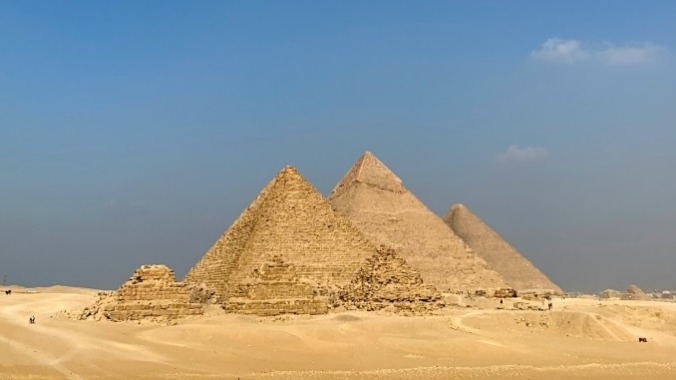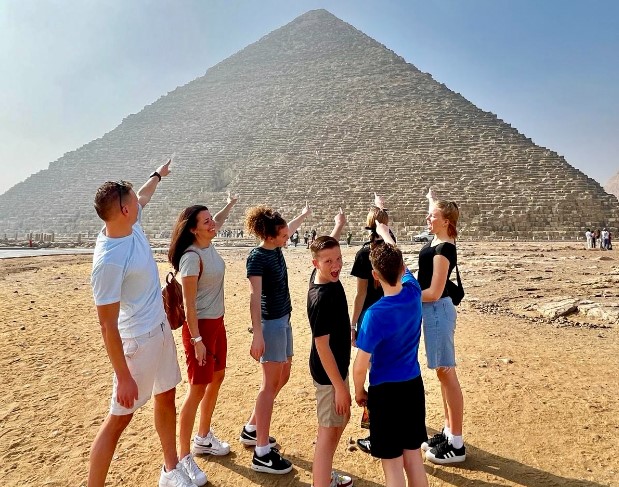Classic Cairo: 5 Things to Know Before Visiting The Pyramids of Giza
Main photo from Unsplash. Snow family photo courtesy of Blake Snow. Travel Features Egypt
“Get Out There” is a column for itchy footed humans written by long-time Paste contributor Blake Snow. Although different now, travel is better than ever. Today we visit the oldest “Wonder of the World” in Egypt’s capital: the Pyramids of Giza.
Visiting the Pyramids of Giza on the outskirts of Cairo during festive Ramadan is one of the most memorable trips I’ve ever taken. There is so much to love about the Middle East’s biggest city, its people, and the hectic energy that never dies here.
But there are also some unsettling frictions that make Cairo a little more work than it should be when compared to other international destinations that are easier to navigate. I never felt unsafe, even with war next door. But the “extra everything” can wear on you.
Here are five things to know before visiting the world’s oldest, largest, and most awe-inspiring pyramids.
The Pyramids are an iconic, awesome wonder that every globetrotter should see
I knew my family made the right choice coming here within seconds of walking up to the Great Pyramid early in the morning. At 500 feet tall, it and its two famous companions are 5000 years old (twice as old as the second oldest “Wonder of the World” in China, The Great Wall) and took 20,000 ancient Egyptians over 20 years to build. That’s crazy! Built to glorify the pharoahs entombed inside, these pyramids are the only ancient Wonder still standing because they were perfectly engineered by brilliant Egyptians using the biggest rock blocks you’ll ever see in your life.
Built on an elevated plateau and right next door to the city, the Pyramids are a lot less sandy than you might think. The complex is mostly solid rock with pebbles and shallow patches of sound scattered about. The seemingly sunken in the ground Sphinx was a little underwhelming. But touring all three large pyramids on foot, camels (our favorite), and by van was a great way to spend our first half day in the city. You could easily spend a full day here if you walk around more. To avoid crowds, go early in the morning from Sunday to Thursday and bring lots of sunblock and water.
Cairo will challenge Western comfort zones at every turn
When I said hectic energy, I meant it. The Egyptian capital rarely sleeps. Even families can be seen walking around past 2 a.m. as if it were 7 p.m. Pedestrians, tuk tuks, camels, horse drawn carriages, motorcyclists, and cars from every decade share the same roads with no street signs, stop lights, or rhyme or reason. It all works. Except for the old man that sadly got hit by a car. No cops were called. A tuk tuk rushed him to the hospital. I was dumbfounded every time I tried to make sense of it.
Like Japan, Egypt is 99% ethnically homogenous, which means non-Egyptians stick out like a sore thumb, especially girls and women—even ones wearing knee length shirts and tshirts. Female elbows and calves just aren’t something most Muslims see everyday, and the unwanted stares left my wife and teenage daughters a little unsettled, as if they were walking around in bikinis. They never felt unsafe. Egypt is a safe country. But the glances and occasional jeers were uncomfortable at times.
So were the nominal surcharges, calls for tips, paying for bathrooms after already paying to get into the pyramids, this, that and the other. It almost never ends, is very extra, and pushes you beyond your comfort zone, albeit mostly in a positive direction.

Recommended guides come with trip-saving perks but you can do it yourself
“Are you hiring a security detail?” my neighbor asked upon hearing we were traveling to Egypt for spring break. We hadn’t, nor do you need to, unless you’re a head of state or celebrity. Statistically the biggest crimes you’ll be exposed to are petty theft, ogling, and a few dishonest tourism vendors.
Hiring guides can shield you from much of the above, however, in addition to bypassing attraction lines, giving you a heads up on pesky vendors, context for what you’re seeing, and even airport custom lines. We used them half of the time and are glad we did. But more intrepid travelers can and regularly do see the Pyramids, Cairo, and greater Egypt all by themselves. Whatever you decide, just be polite and firm and you shouldn’t encounter any trouble.
Stay in Giza for more immersive views; Downtown Cairo for creature comforts
To get away from the tourist areas, my family stayed in a Giza Airbnb with a balcony view of the Pyramids in a middle class, if not “work in progress” part of town. I’m glad we did, as the cultural exchanges were a lot more meaningful, educational, and memorable here. For example, one restaurant owner insisted that my family eat for free as an act of kindness. Another man freely pointed me in the right direction and asked me to remember that the majority of Egyptians are truly here to help, unlike some of the sly tour guides or vendors who have a reputation for being overly pesky, if not treating foreigners as merely assets to be maximized. Seeing the pyramids under different lighting conditions in between sightseeing never got old, nor did the red crescent moon we saw on our first night.
If that doesn’t interest you, there are much bigger and nicer American-owned hotels in downtown Cairo on the Nile. They’re all very shiny and comfortable but not particularly distinct. As for me and my house, I’m glad we stayed in a palatial, marble, three bedroom apartment on the eighth floor with a balcony overlooking the pyramids and the busy streets of Giza down below. It provided some of the best people watching I’ve ever enjoyed abroad.
Either way, you’ll be exposed to a whole new world, plus early morning prayer calls that wake you up at 4:30 a.m.
Don’t miss museum mummies, massive mosques, top foods, and stellar street markets
In addition to the Pyramids, I highly recommend the mummies and King Tut treasures at the Egyptian Museum, the Muhammad Ali Mosque, and Al Moez and Khan el-Khalili street markets. I also loved the highly affordable and delicious food, namely koshary (Egyptian lentil pasta), Ful and Ta’meya (Egyptian beans and rice with falafel, pita, and lots of dipping sauces), and kebab and kofta (Egyptian BBQ with pita and lots of dipping sauces). Oh, and the thick, semi frozen watermelon, strawberry, and mango juices which are the best I’ve had anywhere.
I’d skip the popular Nile dinner cruises, though, which we found to be both overpriced and cheesy. Either way, you can see and do most of what the city has to offer in 3-5 days, depending on how fast you move.
See also: Hiking Petra, One of the 7 Wonders of the World
Blake Snow contributes to fancy publications and Fortune 500 companies as a bodacious writer-for-hire and frequent travel columnist. He lives in Provo, Utah with his family of seven and one ferocious chihuahua.